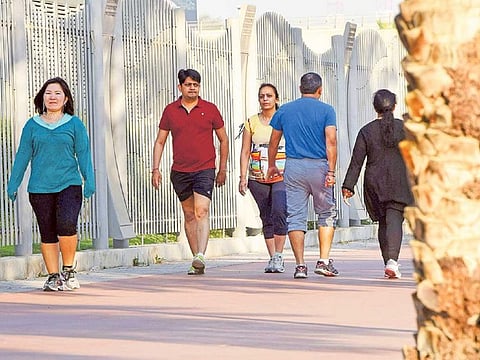7 surprising benefits you get by walking after dinner
New study shows 15-minute post-meal walks curb blood sugar spikes

Highlights
- Researchers have discovered a simple — and effective — way to reduce blood sugar spikes, particularly in older adults with pre-diabetes.
Amid our busy lives, prioritising health by simply finding time for post-dinner moderate-pace walks can have surprising benefits, a study shows.
Taking a short 15-minute walk after each meal appears to be the key to maintaining more stable blood sugar levels throughout the day, whole-room calorimetry researchers reported.
Their study, published in the Diabetes Care journal, indicates that three brief post-meal walks can be as beneficial for controlling blood sugar over a period of 24 hours as a single 45-minute walk at a moderate pace.
This brings promising news especially for seniors, who are more susceptible to diabetes.
Evening walk after dinner
Remarkably, researchers found that an evening walk after supper was particularly effective in lowering blood sugar levels. Since the evening meal is often the largest of the day, it has the potential to significantly elevate 24-hour glucose levels.
The study was conducted at the Clinical Exercise Physiology Laboratory at the George Washington University School of Public Health and Health Services.
It made use of whole-room calorimeters (WRM), providing a controlled environment for analysing energy expenditure by measuring air samples.
What is calorimetry?
Calorimetry is the science associated with determining the changes in energy of a system by measuring the heat exchanged with the surroundings during a certain time interval. It is the process of measuring the amount of heat released or absorbed during a chemical reaction. In short, it measures the quantity of heat transferred to or from an object. The flow is passed through a tank partly filled with water whose thermal capacity and weight are known before the beginning of the experiment. By knowing the change in heat, it can be determined whether or not a reaction is exothermic (releases heat) or endothermic (absorbs heat).
The balance between oxygen consumption and carbon dioxide production varies with the individual's activity level, and the WRM also tracks the body's use of various food fuels.
In the study, 10 participants spent time in these small calorimeter rooms, each equipped with basic amenities.
Standardised meals were provided, and blood sugar levels were continuously monitored. The participants had three 48-hour periods in the rooms: one without exercise, one with 15-minute post-meal walks, and one with a 45-minute walk either in the late morning or before supper.
How exercise eases symptoms of depression and anxiety
While the precise connections between exercise and conditions like depression and anxiety remain somewhat elusive, it's evident that engaging in physical activity can effectively alleviate the symptoms of these disorders and enhance one's overall well-being. According to an article published by Mayo Clinic, exercise may serve as a preventive measure, reducing the risk of depression and anxiety recurrence once an individual has achieved a state of improved mental health.
Results
The results indicated that the post-meal walk after supper was the most effective at regulating blood sugar levels for a full 24 hours.
This simple practice appeared to significantly reduce the typical post-supper blood sugar spike, which often extends into the night and early morning.
The findings provide hope for individuals in their 70s and 80s, making daily, intermittent physical activity a more attainable and effective way to manage blood sugar.
Sign up for the Daily Briefing
Get the latest news and updates straight to your inbox






